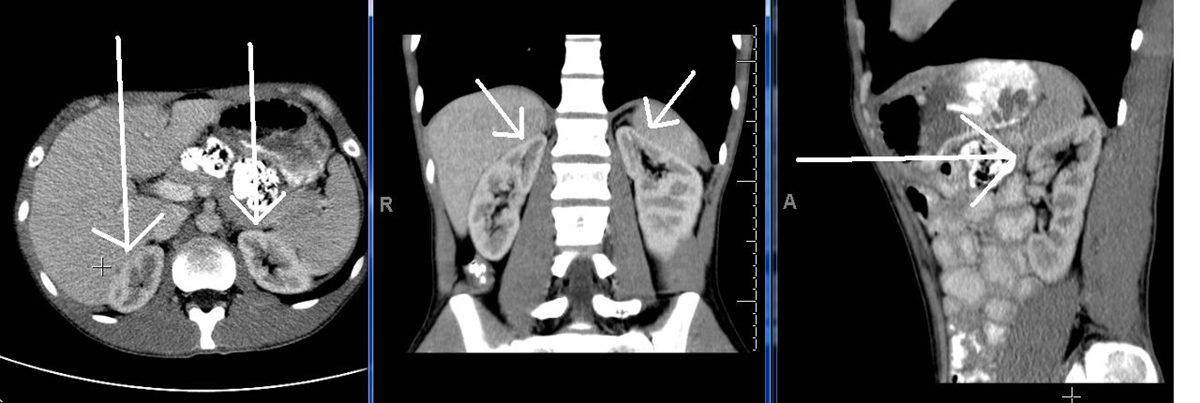
Under normal circumstances the human body comprises two adrenal glands, both situated at the top of the kidneys. These glands are relatively small but play immense role in the body being in charge of synthesizing several vital hormones. Each and every adrenal gland has the central part called the medulla and the peripheral tissue known as the cortex. The cells of the medulla produce epinephrine and norepinephrine. These two hormone, which also act as neurotransmitters, are not vital for life. Still, they help people cope with physical and emotional stress. On the other hand, hormones produced in the cortex of the gland are essential to life. These include corticosteroid hormones (hydrocortisone and corticosterone), aldosterone and androgenic steroids.
Adrenal Insufficiency in the Body
The adrenal gland may be affected in such way so that only one of its hormones is not properly synthesized. However, sometimes the damage is much more complex, the gland might be completely damaged which mirrors in total adrenal insufficiency, the state when none of the hormones is being produced.
If the gland is not capable of producing sufficient amounts of cortisol, the person might be suffering from adrenal dysgenesis, impaired steroidogenesis or adrenal destruction.
Adrenal dysgenesis is a rare genetic disorder characterized by lack of cortisol production due to congenital structural and developmental defects of the adrenal gland. The condition may develop due to a variety of gene mutations.
Furthermore, lack of cortisol might stem from impaired steroidogenesis. The shortage of cholesterol (the precursor of cortisol) is, for instance, reported in Smith-Lemli-Opitz syndrome when patients experience interruptions in the delivery of cholesterol which in the long run affects the synthesis of cortisol. Similar effects are noticed in patients suffering from abetalipoproteinemia.
And finally, lack of practically all hormones of the adrenal gland, a characteristic of Addison's disease, is observed in people in whom the gland has suffered severe damage. Autoimmune destruction is closely connected with an immune reaction against the specific enzyme. The damage to the gland is either isolated or the affected individuals additionally suffer from damage to other hormone-producing organs, the thyroid gland and pancreas in particular. Complete destruction of both, the cortex and the medulla are seen in patients suffering from certain types of cancer when the tumor gives metastases to the adrenal gland. Also, it is possible to develop the condition if there is severe hemorrhage into the gland or in case the gland is affected by tuberculosis, amyloidosis or histoplasmosis.
It is of utmost importance to mention suppression of the patient's adrenal glands which develops as a consequence of intake of glucocorticosteroids which are prescribed in certain illnesses. Fortunately, the function of the gland restores months after discontinuation of exogenous corticosteroids.
Symptoms of Addison's Disease
By definition Addison's disease is a chronic endocrine disorder characterized by absence of steroid hormones as well as other hormones produced by the gland. This is a rather severe disorder which requires lifelong treatment with steroids and close monitoring.
Symptoms of Addison's disease tend to develop rapidly and are relatively complex which might influence the speed of diagnosing the condition. In the majority of cases there is fatigue, lightheadedness experienced while standing upright, muscle weakness, muscle/joint aches and pains and excessive perspiration. Patients also complain about fever, have difficulty standing up and experience anxiety, nausea and vomiting along with diarrhea and weight loss. There are changes in mood and personality too. Since the body loses large amounts of sodium, patients have marked cravings for salt and salty foods. One of the typical characteristics of Addison's disease is skin hyperpigmentation. Changes in color of the skin result from a decrease in cortisol and associated increase in ACTH levels.
Since the production of glucocorticoids is practically non-existent, the body releases increased amounts of ACTH, a hormone produced by the pituitary gland which is supposed to stimulate the adrenal gland. However, since such stimulation is practically inefficient, ACTH has no effects and its level rises. Elevated ACTH levels are easily confirmed with simple blood test. The excess of ACTH is actually a reason white the skin of patients with Addison's disease gets that specific bronze color. Hyperpigmentation is distributed all over the body, including parts that are normally not exposed to the sun. The most common sites of skin changes are the hands, the buccal mucosa and nipples. The olds scars may also change their color.
Still, a well experience physician will eventually confirm the illness and initiate the treatment. Most patients receive treatment and successfully avoid adrenal crisis, one of the most severe complications of the disease.
The goal of the treatment is to maintain adrenal hormones within optimal range. Cortisol substitutions is necessary for the rest of patient's live. The dose of the prescribed drugs is determined upon the needs of the body. Namely, under normal circumstance, the dose of exogenous hormones does not have to be high. Increase in dose is indicated only when the body is under excess stress brought along by infections and other acute illnesses.
All in all, even though Addison's disease is a complex medical condition, thanks to advancements in treatment it is easily dealt with and the average life expectancy for patients has drastically improved over the last 50 years. However, in spite of highly successful treatment these patients are at higher risk of developing other diseases. Namely, they are more susceptible to heart disease and cancer compared to healthy population.

















Your thoughts on this
Loading...